The AMD Trinity Review (A10-4600M): A New Hope
by Jarred Walton on May 15, 2012 12:00 AM ESTAMD Trinity General Performance
Starting as usual with our general performance assessment, we’ve got several Futuremark benchmarks along with Cinebench and x264 HD encoding. The latter two focus specifically on stressing the CPU while PCMarks will cover most areas of system performance (including a large emphasis on storage) and 3DMarks will give us a hint at graphics performance. First up, PCMark 7 and Vantage:
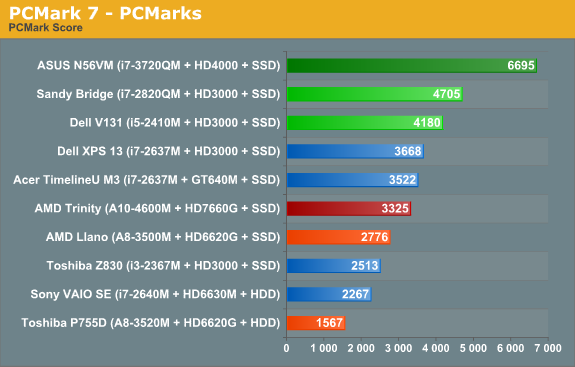
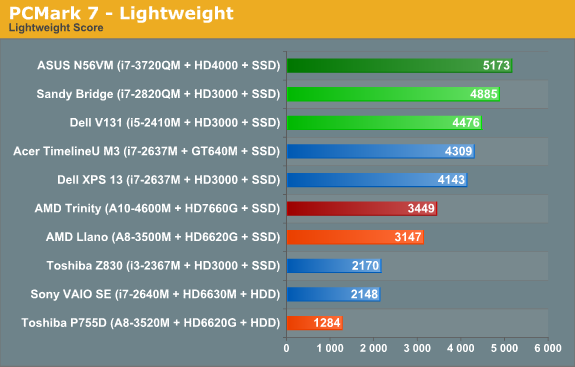
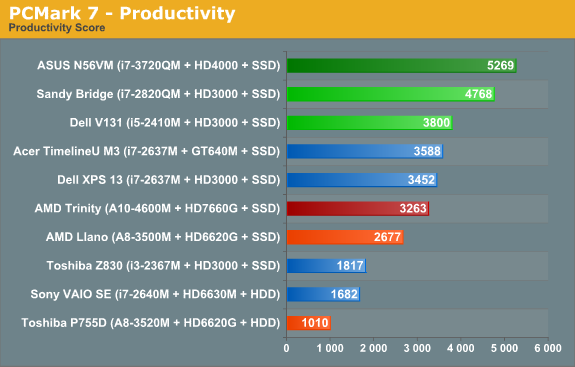

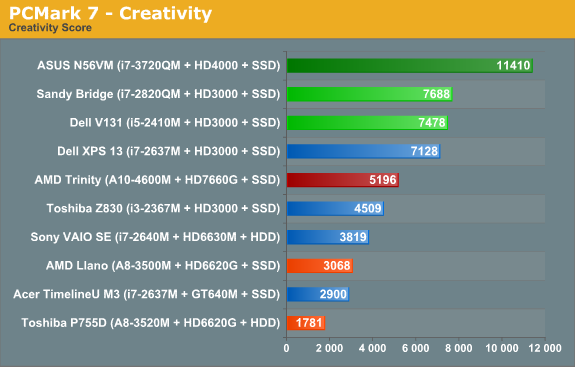
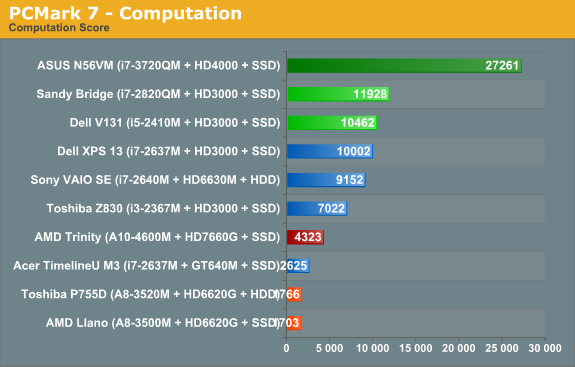
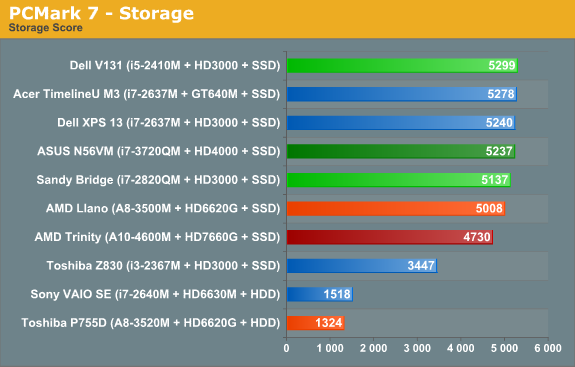
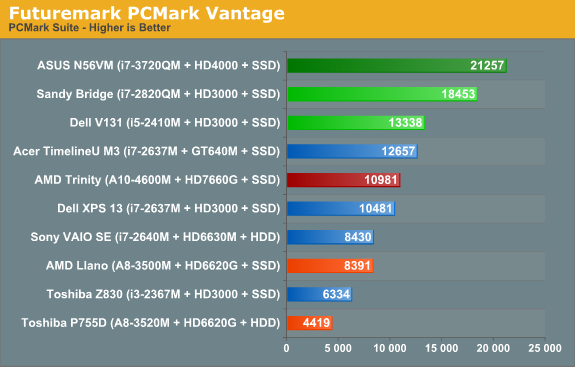
As noted earlier, we ran several other laptops through PCMark 7 and PCMark Vantage testing using the same Intel 520 240GB SSD, plus all the ultrabooks come with SSDs. That removes the SSD as a factor from most of the PCMark comparisons, leaving the rest of the platform to sink or swim on its own. And just how does AMD Trinity do here? Honestly, it’s not too bad, despite positioning within the charts.
Obviously, Intel’s quad-core Ivy Bridge is a beast when it comes to performance, but it’s a 45W beast that costs over $300 just for the CPU. We’ll have to wait for dual-core Ivy Bridge to see exactly how Intel’s latest stacks up against AMD, but if you remember the Llano vs. Sandy Bridge comparisons it looks like we’re in for more of the same. Intel continues to offer superior CPU performance, and even their Sandy Bridge ULV processors can often surpass Llano and Trinity. In the overall PCMark 7 metric, Trinity ends up being 20% faster than a Llano A8-3500M laptop, while Intel’s midrange i5-2410M posts a similar 25% lead on Trinity. Outside of the SSD, we’d expect Trinity and the Vostro V131 to both sell for around $600 as equipped.
A 25% lead for Intel is pretty big, but what you don’t necessarily get from the charts is that for many users, it just doesn’t matter. I know plenty of people using older Core 2 Duo (and even a few Core Duo!) laptops, and for general office tasks and Internet surfing they’re fine. Llano was already faster in general use than Core 2 Duo and Athlon X2 class hardware, and it delivered great battery life. Trinity boosts performance and [spoiler alert!] battery life, so it’s a net win. If you’re looking for a mobile workstation or something to do some hardcore gaming, Trinity won’t cut it—you’d want a quad-core Intel CPU for the former, and something with a discrete GPU for the latter—but for everything else, we’re in the very broad category known as “good enough”.


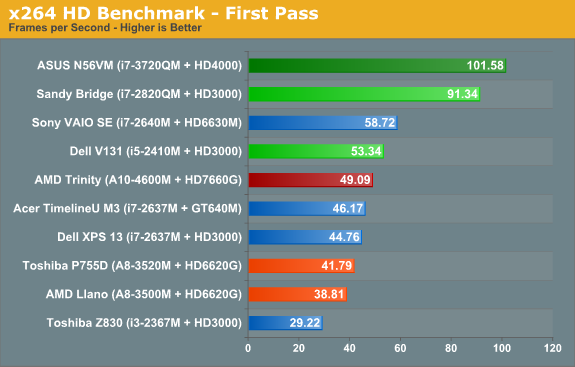
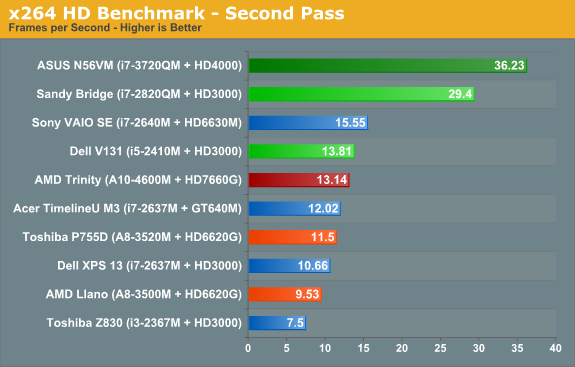
When we start drilling down into other performance metrics, AMD’s CPU performance deficiency becomes pretty obvious. The Cinebench single-threaded score is up 15% from 35W Llano, but in a bit of a surprise the multi-threaded score is basically a wash. Turn to the x264 HD encoding test however and Trinity once again shows a decent 15% improvement over Llano. Against Sandy Bridge and Ivy Bridge, though? AMD’s Trinity doesn’t stand a chance: i5-2410M is 50% faster in single-threaded Cinebench, 27% faster in multi-threaded, and 5-10% faster in x264. It’s a good thing 99.99% of laptop users never actually run applications like Cinebench for “real work”, but if you want to do video encoding a 10% increase can be very noticeable.

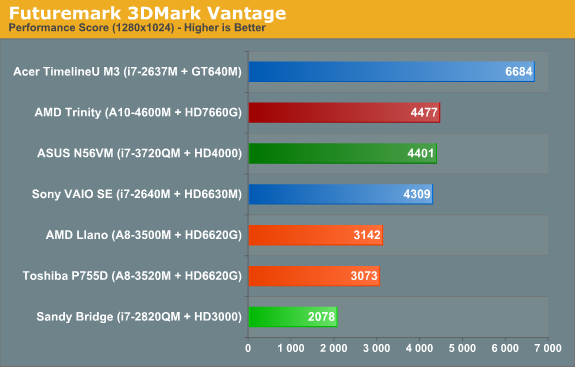
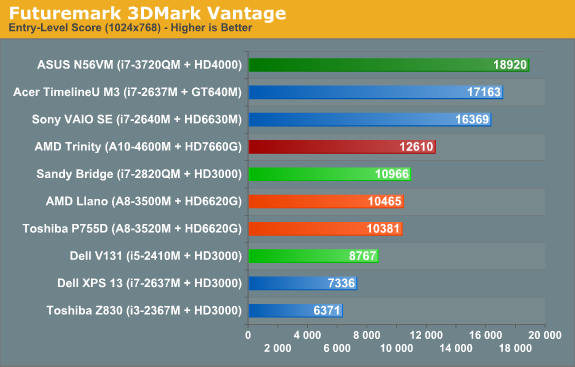
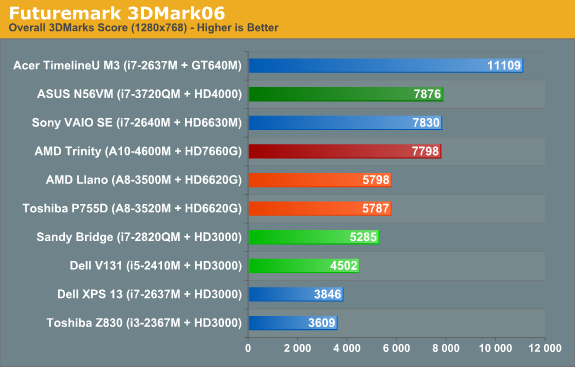
Shift over to graphics oriented benchmarks and the tables turn once again...sort of. Sandy Bridge can’t run 3DMark11, since it only has a DX10 class GPU, but in Vantage Performance and 3DMark06 Trinity is more than twice as fast as HD 3000. Of course, Ivy Bridge’s HD 4000 is the new Intel IGP Sheriff around these parts, and interestingly we see Trinity and i7-3720QM basically tied in these two synthetics. (We’ll just ignore 3DMark Vantage’s Entry benchmark, as it’s so light on graphics quality that we’ve found it doesn’t really stress most GPUs much—even low-end GPUs like HD 3000 score quite well.) We’ll dig into graphics performance more with our gaming benchmarks next.










271 Comments
View All Comments
medi01 - Thursday, May 17, 2012 - link
That's simply BS, my dear.Most of the "starting" task is HDD bottlenecked.
Having a lot of apps loaded is RAM constrained.
It has ABSOLUTELY NOTHING to do with CPU power.
B3an - Thursday, May 17, 2012 - link
Yeah because the CPU just does nothing, at all, ever. It just sits there totally idle all the time right.medi01 - Friday, May 18, 2012 - link
That's exactly what modern CPUs do (for quite a while) in a majority of PCs most of the times: IDLE. You didn't know that? Oh well. (Gamers being an exception)I encode video a lot (so far the most CPU extensive task besides gaming that you can imagine at home, which seems to be shifting towards GPU though) and even that is a "batch" task, I couldn't care less whether it is finished at 2pm or 3pm at night.
sviola - Tuesday, May 15, 2012 - link
Well, load eclipse or Visual Studio, a local DB server, a local application server, a few browser windows, some spreadsheets and documents, a couple of IM and some terminal windows and you got my usual work setup running. It can be demanding on the CPU and sometimes make the system slow down. And waiting for the system to respond can be frustrating in these situations, not mentioning having to compile all the project...mpschan - Tuesday, May 15, 2012 - link
Are you really expecting to do all that processing on a 500-700 dollar laptop? You're clearly doing work-related activities, which is not the target consumer here.Spunjji - Wednesday, May 16, 2012 - link
+100. Tired of this ass-hattery.mikato - Wednesday, May 16, 2012 - link
I think your biggest problems there would be Eclipse/Visual Studio. Also if you're using MS SQL Server as the DB (with Management Studio?) then definitely that too. And I don't know what app server you mean. Compiling projects? This stuff can be slow on a desktop, come on. How about using a lighter IDE or Notepad++ or MySQL for the DB.... or doing this work on a desktop like everyone else.medi01 - Thursday, May 17, 2012 - link
Mentioned example sickens me. I do similar stuff. Except I also have virtual machine running on top of things.NOT ENOUGH RAM is what you get in these situation, not slow CPU!!!!
CeriseCogburn - Thursday, May 24, 2012 - link
Well then all core 2 / duo users can just upgrade their ram no need for this trinity laptop crap.No buying anything but some cheap ram.
Glad to hear it.
xd_1771 - Tuesday, May 15, 2012 - link
BSMonitor, none of those tasks are CPU intensive and will consume less than 50% of that CPU.Your analogy is completely backwards. With programs INCLUDING video playback programs (seriously, I want you to name a popular video codec that isn't going to be accelerated by this GPU - this standard has existed for a number of years), office programs (Office 2010 and up) and pretty much every major web browser in existence having moved onto making large use of GPU acceleration, CPU will start ceasing to matter. The Trinity APU is very well balanced for the performance on both sides that it offers.
With more TRUE cores to balance non-intensive CPU workloads around than the competition, it arguably offers much better multitasking ability.